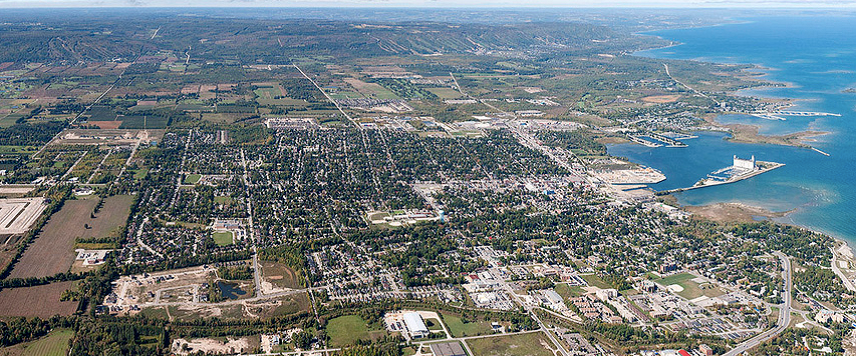Protecting Local Natural Heritage from Development
Contents
By George Powell, WAG member
The loss and fragmentation of natural habitats in the Blue Mountain Watershed continues to present challenges for municipalities, planners and environmental scientists tasked with identifying areas that should be preserved for the long-term sustainability of the ecosystem. This is why the Blue Mountain Watershed Trust Foundation reviews and makes recommendations on development applications in the Blue Mountain Watershed for better protection of natural features.
Examples of a few of the development applications that we have reviewed and commented on are:
- TOWN OF THE BLUE MOUNTAINS: the Castle Glen Development, the Conn gravel pit expansion, the Meridian Development
- CLEARVIEW: the new Walker Duntroon quarry, reconstruction of Side Road 26/27, the Aviation Commerce Centre adjacent to the Collingwood Municipal Airport
- COLLINGWOOD: the Consulate developments, Huntingwood Trails developments.
- GREY HIGHLANDS: the new St. Mary’s quarry
It is our position that these developments, some of which have been approved, are located in areas that could seriously damage natural habitats for the long term and that need to be preserved.
One of the ways to protect these precious features is by providing an ecological buffer area that adequately separates development from the natural heritage features. This is one of the most challenging and controversial aspects of land use planning that we face.

Legislative and Policy Issues
The Ontario Planning Act and the Growth Plan for Greater Golden Horseshoe, along with the Provincial Policy Statement (PPS), sets out the legal requirements for land development in the province.
Under Section 2.0 of the PPS, Natural Heritage policies are in place. These are intended to protect natural heritage features by prohibiting development (in S. Ontario) in:
- Significant wetlands
- Significant woodlands
- Significant valley lands
- Significant wild life habitat
- Significant areas of natural and scientific interest (ANSIs)
- Diversity and connectivity of natural features (recommended only)
- The habitat of endangered and threatened species
- Fish habitat
While the PPS does not provide specific guidance on buffers, its primary supporting document [the Natural Heritage Reference Manual (NHRM)] does provide guidance for a consistent approach to protecting natural heritage features but it lacks legal status. We have recommended in our recent review of the PPS that it should be referenced and revised to play a more prominent role in the determination of adequate buffer areas.
A very critical and sensitive part of our watershed lies within the area delineated in the Niagara
Escarpment Plan (NEP) and as such falls under the Niagara Escarpment Protection and development Act. Therefore, the Niagara Escarpment Commission must be consulted when preparing and reviewing development applications in the NEP areas. As with the PPS, while the NEP does not include any minimum buffer requirements, it includes a number of policies related to buffers and setbacks. More importantly, the development restrictions are stricter in the NEP than in the PPS. In areas designated as Escarpment Natural, all new developments are prohibited, with the exception of essential infrastructure.
Municipal councils under the Planning Act have the responsibility to protect provincial interests and natural heritage features in their municipality as defined in the PPS. As is the case with the PPS, Official Plans normally do not include any minimum buffer requirements and we recommend that this be changed. The Official Plan (OP) of a municipality is their key document for protecting natural heritage. The OP should identify areas of provincial interest in the municipality and establish land use designations and policies to protect them for the long term. A development proposal is not permitted on lands adjacent to the natural features listed above until they have been evaluated and it has been demonstrated that there will be no negative impacts. The municipalities in our watershed are required to consult with either the Nottawasaga Valley Conservation Authority (NVCA) or Grey Sauble Conservation Authority (GSCA) for a review of the proponent’s environmental impact study and to provide their expert opinion on the development’s impact on natural features or ecological functions.
This is a challenging assignment as it is very difficult to get adequate separation, i.e., buffers between natural features and developed areas. There is considerable room for opinion and judgment because assessment of environmental harm is not entirely science-based. The municipality has the authority in the OP to go beyond the protection provided by the PPS but that rarely happens.
Throughout this whole process, the developer has the option of appealing to the Ontario Municipal Board (OMB). In our experience, the OMB has been more sympathetic to developers’ opinions of buffer adequacy than to the opinions of opponents.
OP Review and NHS studies
The Town of Collingwood is currently in the process of reviewing the Environmental Protection Section in the OP and will be incorporating the Natural Heritage Systems (NHS) study that was carried out by NVCA in 2011 (and has been independently peer reviewed). In the Schedules attached to the draft Plan they show proposed land uses. Schedule A2 – Land Use Plan shows a development much of which is constructed in the environmental protection areas shown in blue, and to which a buffer area would need to be added. This is an example of how the Natural Heritage Systems study, if it was in place at the time of the development application, could have prevented this likely harm to the NHS area.
Collingwood is presently circulating the proposed OP Section 4 – Environmental Protection – and asking for comments from agencies and the public. It is expected to be in place later this year. The Trust is monitoring this process with hopes to ensure the maximum protection possible.
Grey County has recently completed their NHS. It still needs to be approved and incorporated into their OP.
The Town of the Blue Mountains has been monitoring the work being completed under Grey
County’s Natural Heritage Study and will be incorporating related parts of that study into their
Official Plan through an amendment process. Simcoe County has received final comments on their OP from the Ontario Municipal Board. It still needs to be approved by County Council. Their OP has a clause in it to try and protect Natural Heritage features but there is no plan attached indicating known natural heritage features, as is the case in Collingwood and Grey County.
Grey Highlands and Clearview Townships need to carry out a NHS and hopefully will incorporate them into their OPs.
Conclusion
When the NHSs in our watershed have been approved and incorporated into the municipalities’
OPs, far better guidance will be available to focus development interests to more suitable areas in the municipality that are not in conflict with natural heritage features.
We believe the PPS and OP need to be amended and recommendations with respect to buffers should be stated minimums and not be subject to reduction. In cases where protecting the habitat of endangered species or threatened species is required, they may need to be increased even beyond the minimums. The developer should provide this information and the conservation authorities should be required to investigate and have final approval of the buffer areas proposed.


